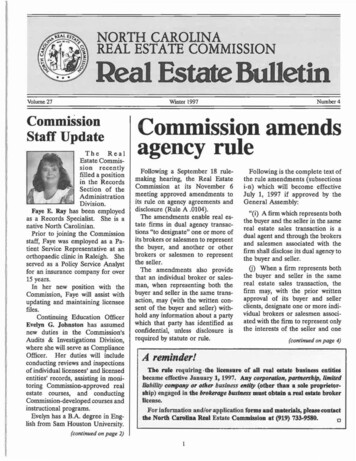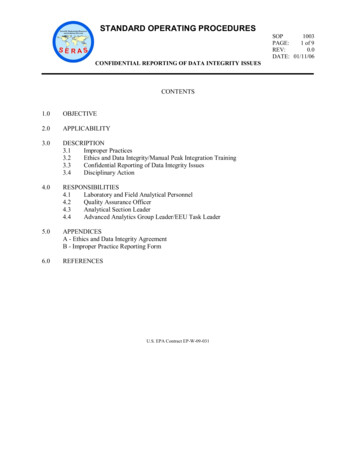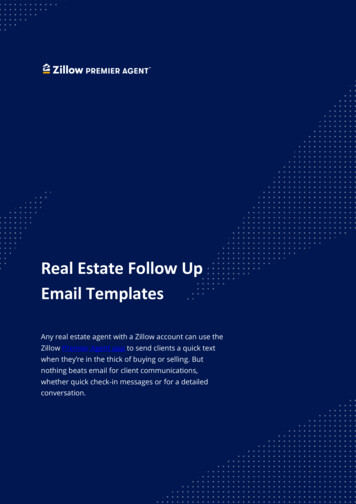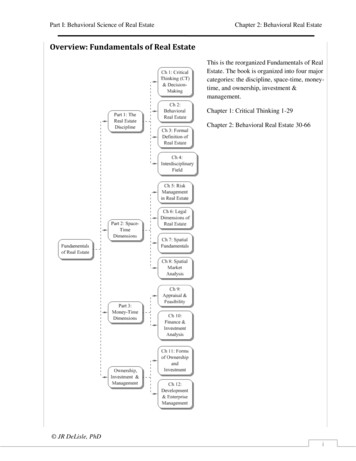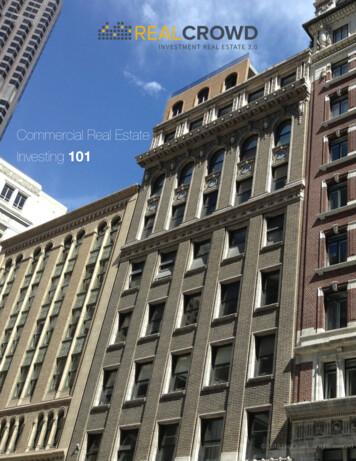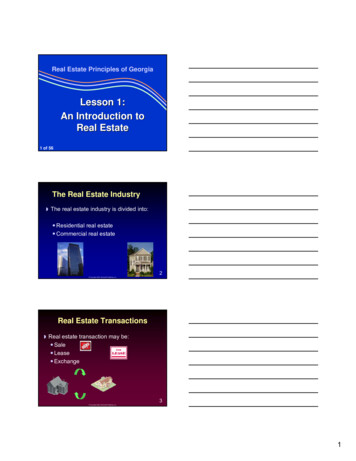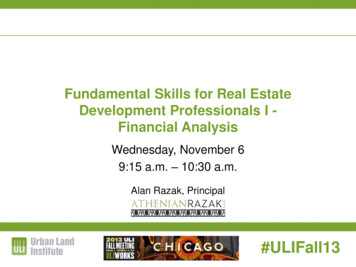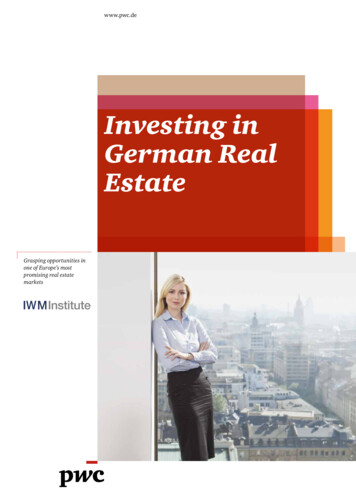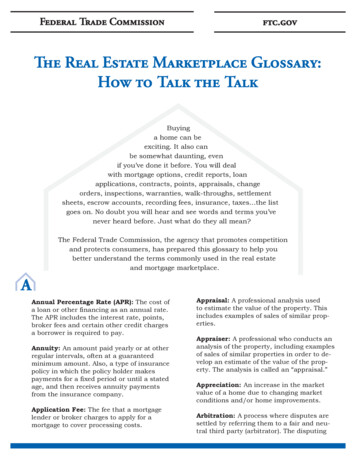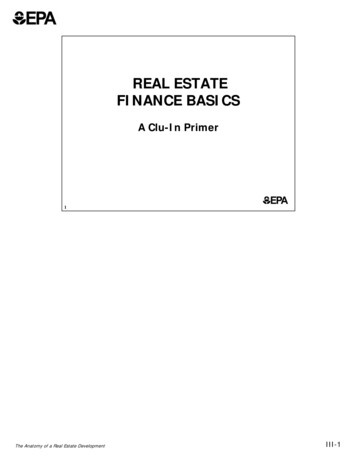
Transcription
REAL ESTATEFINANCE BASICSA Clu-In Primer1The Anatomy of a Real Estate DevelopmentIII-1
Real Estate/EnvironmentalValue PyramidReal Estate value exceedsremediation costmarginalUpside downprojects2Discussion Notes:Properties with contamination are unusually complex and difficult to develop. Some contaminated sites havesignificant real estate potential, some have some value that can be uncovered, and some have very limitedeconomic value.Redeveloping contaminated sites is not an easy task. Many sites are heavily encumbered, and not immediatelydevelopable. The key is to make the site attractive to the general real estate market.This process can be used to determine if the site is a valuable one, a marginal one, or if it is seriously upsidedown. The discussion will look at EPA’s use of the Reuse Assessment and how a developer might view the sameprocess.The Anatomy of a Real Estate DevelopmentIII-2
Who is the Real Developer? Developer Adds Value Equity:¾must have money at risk Ownership:¾must have control of site Financing:¾must have financial capability to complete project Tenant/User:¾must have tenant or capacity to attract tenant/user3Discussion Notes:Understand who the real developer (decision-maker) is. The developer adds value to the project.How does one assess the capability of a developer to complete the project? The real developer is not alwaysapparent. Many individuals in a deal may represent themselves as the developer, but it is important tounderstand who the real developer is. Equity: must have money at risk(partnerships, LLCs, Community Developers, joint ventures, public/private partnerships) Ownership: must have control of site(options, contacts, liens, title) Financing: must have financial capability to complete project Tenant/User: must be the end user, have one in mind, or have the capacity to attract oneThe Anatomy of a Real Estate DevelopmentIII-3
The Role(s) of the rsDevelopmentTeam4Discussion Notes:The developer wears many hats and performs several functions. Insight into these roles can help oneunderstand the actions developers might take as part of a redevelopment.The Anatomy of a Real Estate DevelopmentIII-4
The Development Team Standard Development: Engineers, Architect, Appraiser, MarketAnalyst, Real Estate Brokers, Attorneys,Mortgage Brokers, Tenants/Users, Lenders,Planners, etc. Contaminated Property, add: Environmental consultants, attorneys,insurers, community representatives5Discussion Notes:Standard Development:Engineers, Architect, Appraiser, Market Analyst, Real Estate Brokers, Attorneys, Mortgage Brokers,Tenants/Users, Lenders, Planners, etc.Contaminated Property, add:Environmental consultants, attorneys, insurers and representatives of the communityThe Anatomy of a Real Estate DevelopmentIII-5
The Development Model Pre-Development Idea, Refinement, Due Diligence Securing the Deal Contract Negotiation, Formal Commitment Development Construction, Completion and Formal Opening Management Property, asset and portfolio management6Discussion Notes:Provide an overview of the Real Estate Development Process in general terms – the steps the developer goesthrough to complete the deal.Key phases in every development. As we will discuss later in the course, these phases can be broken down intosmaller steps, can occur sequentially and/or simultaneously, but are necessary for every deal. Pre-Development: Idea, Refinement, Due diligence (feasibility, marketing, identifying end-user) Securing the Deal: Contract Negotiation, Formal Commitment Development: Construction, Completion and Formal Opening Management: Property, asset and portfolio managementComment:More about the Development Process will be discussed during the second day.The Anatomy of a Real Estate DevelopmentIII-6
Conceiving the Project Highest and best use Mixed use Reuse Assessment Developers start with the current planningand zoning Historic use patterns Objectionable uses (LULUs) Creativity7Discussion Notes:Reuse Assessment:Most developers start by looking for sites that they know will be marketable to end-users. Then, they checkplanning & zoning to see whether the end use works or if a variance is needed. The value of the projectdetermines the developer’s interest in challenging zoning. Different kinds of developers have specific types ofend users in mind.Highest and best use:The concept of highest and best use in development terms is the use that produces the greatest value for theproperty.Objectionable Uses:LULUs – locally undesirable land uses: transfer stations, power plants, jails. Land uses that a neighborhoodwould believe would affect their quality of life. These are always uses that need to go somewhere.Creativity: ice rinks, unusual uses (Meadowlands)The Anatomy of a Real Estate DevelopmentIII-7
Reuse Assessment Property Environmental Community Financial8Discussion Notes:Discuss the four major components of a reuse assessmentThe Anatomy of a Real Estate DevelopmentIII-8
Market Analysis and Feasibility Who will be the end-user What price will end-user pay The impact ofstigma Predevelopmentmarketing Build-to-Suit9Discussion Notes:In undertaking a market analysis, the key question is always: Who will be the ultimate user(s) of the site andwhat price will they pay? Certainly, one can get into reams of demographic data and draw up sophisticated proformas, etc. but at the end of the day, two axioms always dominate:1) Market conditions will call the shots with respect to usage (unless special uses are demanded by the localcommunity, etc.)2) What is the risk/reward ratio? Developers don’t want to pursue projects needlessly if there are hidden "dealbusters" or if they have to spend an inordinate amount of time and effort for a project that is only going to givethem a marginal return. If the payoff is big enough, it might be worth the fight. However, suppose, forexample, that a future liability issue negatively impacts the ability to get financing, it could come back to affectthe pocket book. Developers are not only going to be concerned with the economic issue but also with thepossible impact on reputation.Example:Portland dredge disposal proposal.Discuss how stigma impacts all normal market analyses. Stigma can also be an issue in attracting developersand impact how developers market to an end user.Clearly, many projects are marketed early on for specific users--- retail especially. Projects may become buildto-suit for specific user (big box, restaurants, - specific formulas must be met - Home Depot-Wal-Mart-Grocery)Since formulas are known up front, it is fairly easy to assess reuse potential. Other end users, however--perhaps the industrial warehouse or the garden office complex -- might require a more detailed market analysisto get a sense of viability.Example:Raybestos Superfund Site in Stratford. Bankruptcy court superceded EPA in choosing developer.The Anatomy of a Real Estate DevelopmentIII-9
Feasibility – Due Diligence Evaluating the potential of acontaminated property Quantifying Risk Will project show sufficient return for thework and risk10Discussion Notes:Feasibility: How to evaluate the potential of a contaminated property. Measuring potential costs againstpotential benefits.Will project show sufficient return for the work and risk?What are the anticipated returns?The Anatomy of a Real Estate DevelopmentIII-10
Fatal Flaw Analysis Cleanup approach not quantified Extraordinary construction costsMajor regional employer leavesNIMBYStigma11Discussion Notes:Discuss the fatal flaw analysis.Development based on unrealistic regulatory approvals. Based on unrealistic returns, rental rate, occupancy rates, etc. Approval take longer than anticipated Zoning approval questionable Cleanup approach not quantified Groundwater – bedrock, off-site Uninsurable risk NIMBY – overcoming opposition not worth value Stigma so great that some uses, such as residential, are not marketableComment:More about the fatal flaw analysis will be discussed during the second day.The Anatomy of a Real Estate DevelopmentIII-11
“Back of the Envelope”Feasibility – Land Only Land Value Clean 1,000,000 Acquisition Costs Remediation Tax Lien Soft Costs Total 300,000400,000100,000200,0001,000,000 Does it work?12Discussion Notes:Discuss how a developer begins to make sense of the numbers. Developers invest a substantial amount oftime and effort in determining feasibility – these are opportunity costs. Developers often run a “back of theenvelope” feasibility before investing large sums in detailed due diligence.Discuss sample “back of the envelope” feasibility:Land Value Clean 1,000,000 – based upon recent appraisalAcquisition CostsRemediationReal Estate Tax LienSoft Costs 300,000400,000100,000200,000––––purchase & sale contractpaid by buyer, fixed price contract backed by cost cap insurancepaid by buyeropportunity costs, attorneys, environmental consultants,environmental insuranceAcquisition and remediation cost equals clean value, not bargain. Profit in project must come from thedevelopment.Discuss alternative acquisition scenarios, for example: If seller were to accept negotiated price of Plus indemnities and insurance at a cost of Then total acquisition cost is 100,000 75,000 175,000Leaves some 125,000 potential profit on acquisition.The Anatomy of a Real Estate DevelopmentIII-12
Pro-FormaA statement that represents the probable futurenet operating income of an investment property.This could also be called an:Operating or Cash Flow StatementIncome & Expense AnalysisAPOD (Annual Property Operating Data)13The Anatomy of a Real Estate DevelopmentIII-13
Project Costs:Acquisition, Soft Costs, Hard Costs, Remediation, Carry CostsTotal Project Costs of 100,000Net Operating Income (NOI)Gross Income 14,000Operating Expenses( 4,000)Net Operating Income 10,000Cash on Cash Operating ReturnNOI/Project Costs 10,000/ 100,00010%Leverage 20% Down (Equity of 20,000), 80% Mortgage ( 80,000) at 6%Gross Income 14,000Expenses( 4,000)Debt Service (Carry) 4,800Net Cash Flow 5,200Leveraged ReturnNet Cash Flow/Equity 5,200/ 20,00026%Project Value and CapitalizationNOI/Cap Rate Project Sale Value 10,000/.10RealEstateFinanceBasics Introductionto Leverage 100,00014Discussion Notes:Discuss the use of pro formas. What information is included in a pro forma. Discuss this simple pro forma.If the cap rate is higher, the project value is lower. The cap rate reflects risk. If property is held and rents gohigher, while costs and mortgage remain same, then NOI and Net Cash Flow are higher. If cap rate remainssame, then leverage return and equity value are higher.If after several years Net Cash Flow is 12,000 Project Value is 120,000 (same cap rate) 80,000 mortgagestill in place, equity has doubled to 40,000. You could refinance (80% of %120,000 96,000), pay off firstmortgage and keep 16,000.Project Costs/Project Value Cash on Cash ReturnLeveraged Return and Yield require more calculationInternal Rate of Return measures all cash flows over time, includes residual value.This is a very comprehensive tool that involves inflation and other assumptions. It can be deceptive, but is stillused in the industry extensively.Reference Page:Full page printout of spreadsheet is included in Appendix AThe Anatomy of a Real Estate DevelopmentIII-14
Potential Gross IncomeTotal income attributable to real property at fulloccupancy before vacancy/collection loss andoperating expenses are deducted.15The Anatomy of a Real Estate DevelopmentIII-15
RentContract RentThe actual rental income specified in a lease.Market RentThe rental income that a property would mostprobably command in the open market. This isestimated from the current rents being paid andasked for comparable space as of the date ofanalysis.16The Anatomy of a Real Estate DevelopmentIII-16
Vacancy & Collection LossAn allowance for reductions in potential incomeattributable to vacancies, tenant turnover, andnonpayment of rent.17The Anatomy of a Real Estate DevelopmentIII-17
Effective Gross IncomeThe anticipated income from all operations of thereal property after an allowance is made forvacancy & collection loss.18The Anatomy of a Real Estate DevelopmentIII-18
Operating ExpensesThe periodic expenditures necessary to maintainthe real property and continue production of theeffective gross income, assuming prudent andcompetent management.19The Anatomy of a Real Estate DevelopmentIII-19
Operating Expenses(Include but not limited to) Real estate taxes Insurance Utilities Repair and maintenance General and administrative Management Salaries20The Anatomy of a Real Estate DevelopmentIII-20
Net Operating IncomeThe actual or anticipated net income thatremains after all operating expenses arededucted from effective gross income, butBEFORE mortgage debt service, depreciation,and replacement reserves.21The Anatomy of a Real Estate DevelopmentIII-21
Potential Gross Income (PGI)Less: Vacancy & Collection Loss (V&C)Equals: Effective Gross Income (EGI)Less: Operating ExpensesEquals: Net Operating Income22The Anatomy of a Real Estate DevelopmentIII-22
What is a Cap Rate? Where do theycome from? Investor Surveys Derived from Comparable SalesThe Capitalization Rate (“Cap Rate”) is a marketdriven number. It is essentially a measure of riskand reward.23The Anatomy of a Real Estate DevelopmentIII-23
Residual (or Terminal) Cap RateAn overall capitalization rate used to estimate theresale of a property; usually based on theanticipated stabilized income for the year beyondthe holding period.24The Anatomy of a Real Estate DevelopmentIII-24
Finance: Value & Cap RatesValue (V) Net Operating Income (NOI)Capitalization Rate (R) 1,000,000 120,00012 % 1,500,000
Real Estate Finance Basics Introduction to Leverage 14 Discussion Notes: Discuss the use of pro formas. What information is included in a pro forma. Discuss this simple pro forma. If the cap rate is higher, the project value is lower. The cap rate reflects risk. If property is held and rents go higher, while costs and mortgage remain same, then NOI and Net Cash Flow are higher. If cap rate .File Size: 1MBPage Count: 45

